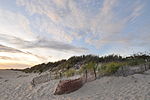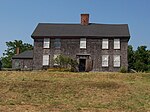Ocean House, Rhode Island
1868 establishments in Rhode IslandHotels established in 1868Hotels in Rhode IslandWesterly, Rhode Island

Ocean House is a large, Victorian-style waterfront hotel originally constructed in 1868 on Bluff Avenue in Watch Hill, Rhode Island. The original 1868 hotel closed in 2003; it was demolished in 2005 and a new facility opened in 2010 on the same site which retained much of the original structure's form and appearance, as well as the original name. Both the original and its reconstruction are noted for their rambling Victorian architecture and distinctive yellow siding. The original Ocean House was the last waterfront Victorian-era hotel on mainland Rhode Island.
Excerpt from the Wikipedia article Ocean House, Rhode Island (License: CC BY-SA 3.0, Authors, Images).Ocean House, Rhode Island
Bluff Avenue,
Geographical coordinates (GPS) Address Website External links Nearby Places Show on map
Geographical coordinates (GPS)
| Latitude | Longitude |
|---|---|
| N 41.310361111111 ° | E -71.853666666667 ° |
Address
Ocean House
Bluff Avenue 1
02891
Rhode Island, United States
Open on Google Maps










